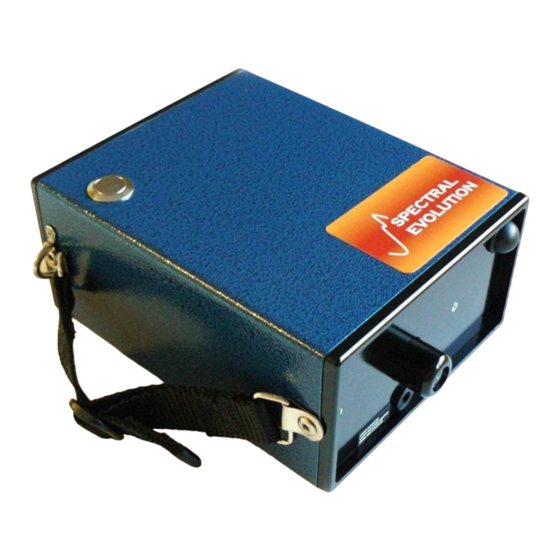
Table of Contents
Advertisement
Quick Links
Advertisement
Table of Contents

Summary of Contents for Spectral Evolution PSR-1100
- Page 1 PSR-1100 Portable Spectroradiometer Operator’s Manual...
-
Page 2: Table Of Contents
Operation ...................... 14 Information and Warnings ................14 Appendix A: Laser Safety ..................... 15 Appendix B: PSR-1100 Specifications ................. 17 Appendix C: Bluetooth Information ................18 ©2012 Spectral Evolution Inc. 90 Sutton St. Unit 4, North Andover, MA 01845 USA... - Page 3 PC, and provides data storage. Calibration data and spectral data (collected in standalone mode, described below) are stored in flash memory. The PSR-1100 has a built-in shutter for automatic dark measurements. The dark current data are retained in RAM and the microprocessor automatically performs mathematical functions on collected spectral scan data, including dark subtraction and automatic integration adjustment.
-
Page 4: Introduction
2.1.2 Battery Pack The PSR-1100 uses a Li-Ion battery pack as a power source, supplied with the system. The Li-Ion battery runs at a nominal 7.4V and is designed to provide more than 3 hours operation following a full charge. When the battery voltage falls too low to power the instrument, it will turn off and go to 0 volts. -
Page 5: Optical Input
(typically called its PIN key or pairing code) the first time you use your PSR-1100. This code is “psr1100”. Your Bluetooth utility will recognize the instrument by a unique name with the syntax “PSR-1100 ####”, where #### is replaced by the serial number of the unit. -
Page 6: Front Panel
See Section 3: Control Panel for more information. 2.1.6 Back Panel The opposite end of the PSR-1100 contains the optical input (lens or SMA fiber optic input), Bluetooth antenna and optional tripod mount. 2.1.7 Laser Scan Switch The Laser Scan switch is located on the top cover of the spectroradiometer. -
Page 7: Interface Specification
2.2 Interface Specification 2.2.1 Battery Pack Your PSR-1100 is supplied with one or more Li-Ion battery packs that fit into the recess on the front panel. Slide the spring-loaded catch to the side (away from the recess) with a finger to insert or remove the battery. -
Page 8: Usb Serial Connector
Baud Rate: 115200 bps Parity: none Data Length: 8 Stop bit: 1 Flow Control: none 2.2.4 ESD protection: +/- 15 KEV human body model, +/- 8KEV contact discharge ©2012 Spectral Evolution Inc. 90 Sutton St. Unit 4, North Andover, MA 01845 USA... -
Page 9: Control Panel
EDIT button changes the parameter settings. 3.3.1 Scan Types The next type of scan to be collected is displayed in row 1 as follows: ©2012 Spectral Evolution Inc. 90 Sutton St. Unit 4, North Andover, MA 01845 USA... -
Page 10: Status Messages
Some possibilities are listed below: (1) LENS 4 – 4 degree FOV lens (2) FIBER1 – standard 25 degree FOV fiber optic ©2012 Spectral Evolution Inc. 90 Sutton St. Unit 4, North Andover, MA 01845 USA... -
Page 11: Modifying A Parameter
(2) Modify the parameter by depressing the EDIT button. The push button switches are programmed to scroll the menu of available options. (3) Depress the MENU button again to save the selected parameter setting. ©2012 Spectral Evolution Inc. 90 Sutton St. Unit 4, North Andover, MA 01845 USA... -
Page 12: Operational/Functional Description
4.1 Setup To use the PSR-1100, install a fully charged battery pack by inserting it into the battery slot located on the instrument’s front panel. Switch the power switch to the ON position. - Page 13 4. Place a reference at the point of measurement making sure to completely fill the field of view of the instrument. This reference measurement is associated with all succeeding measurements until a new reference measurement is established. ©2012 Spectral Evolution Inc. 90 Sutton St. Unit 4, North Andover, MA 01845 USA...
-
Page 14: Operation With A Host Pc
For detailed information on how to use DARWin SP with your PSR Series spectroradiometer, see the DARWin SP User Manual included with your instrument. ©2012 Spectral Evolution Inc. 90 Sutton St. Unit 4, North Andover, MA 01845 USA... -
Page 15: Battery Charger
Also, always power the PSR Series instrument with its battery only. NEVER use the dedicated battery charger to provide power to the instrument. ©2012 Spectral Evolution Inc. 90 Sutton St. Unit 4, North Andover, MA 01845 USA... -
Page 16: Appendix A: Laser Safety
Laser conforms to IEC 60825-1, Ed 1.2. Location – Bottom of instrument, on the product information label. (3) Warning Label Location – Bottom of instrument, on the product information label ©2012 Spectral Evolution Inc. 90 Sutton St. Unit 4, North Andover, MA 01845 USA... - Page 17 PSR-1100 Manual Revision: 1.00 4/5/2012 (4) Aperture Label Location - Next to the laser aperture. ©2012 Spectral Evolution Inc. 90 Sutton St. Unit 4, North Andover, MA 01845 USA...
-
Page 18: Appendix B: Psr-1100 Specifications
15 - 35° C (note: wvl drift 18 - 27° C) Humidity 15 – 90 % non - condensing Storage Temperature 0 - 70° C Humidity 15 – 90 % non - condensing ©2012 Spectral Evolution Inc. 90 Sutton St. Unit 4, North Andover, MA 01845 USA... -
Page 19: Appendix C: Bluetooth Information
Bluetooth Connection Type: Virtual COM Port Bluetooth Connection Pin Key/Pairing Code: psr1100 Revision Changes Date Tracking Original Draft 4/5/11 ® Windows is a registered trademark of Microsoft Corporation. ©2012 Spectral Evolution Inc. 90 Sutton St. Unit 4, North Andover, MA 01845 USA...


Need help?
Do you have a question about the PSR-1100 and is the answer not in the manual?
Questions and answers